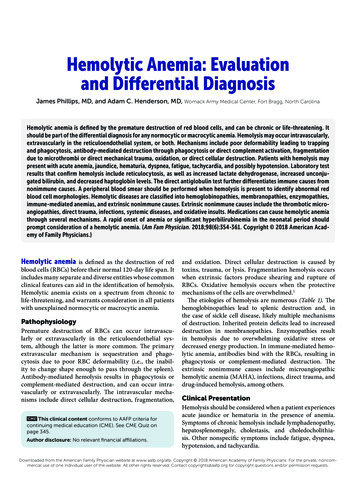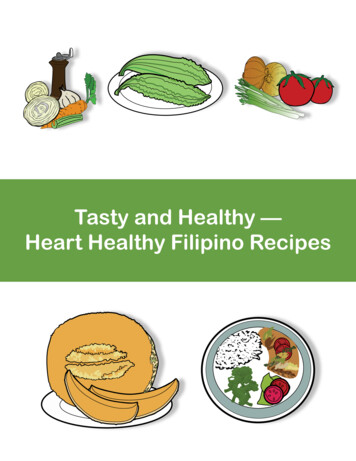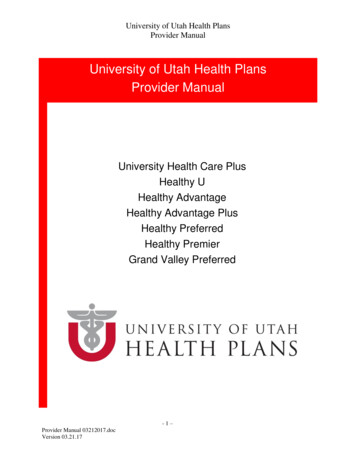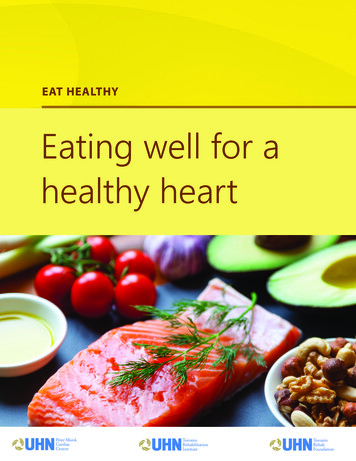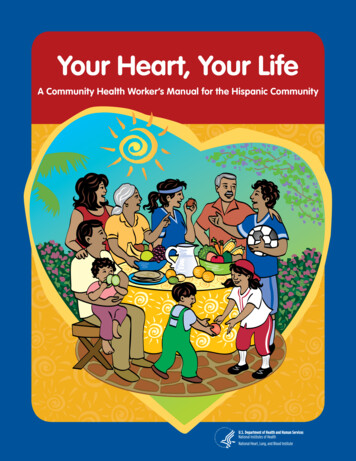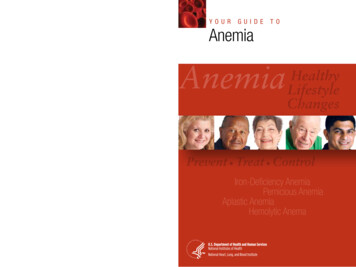
Transcription
Yo urGuid etoAnemiaAnemiaHealthyLifestyleChangesPrevent Treat ControlnnIron-Deficiency AnemiaPernicious AnemiaAplastic AnemiaHemolytic Anema
Y O U RG U I D ET OAnemiaHealthyAnemia LifestyleChangesPrevent Treat ControlnnIron-Deficiency AnemiaPernicious AnemiaAplastic AnemiaHemolytic AnemaNIH Publication No. 11-7629September 2011
ContentsIntroduction . . . . . . . . . . . . . . . . . . . . . . . . . . . . . . . . . . . . . . . . . . . . . . . . 1Anemia . . . . . . . . . . . . . . . . . . . . . . . . . . . . . . . . . . . . . . . . . . . . . . . . . . . . . 2What Is Anemia? . . . . . . . . . . . . . . . . . . . . . . . . . . . . . . . . . . . . . 2What Causes Anemia? . . . . . . . . . . . . . . . . . . . . . . . . . . . . . . . . . . 4Making Too Few Red Blood Cells . . . . . . . . . . . . . . . . . . . . . . . . 5Destroying Too Many Red Blood Cells . . . . . . . . . . . . . . . . . . . 6Losing Too Many Red Blood Cells . . . . . . . . . . . . . . . . . . . . . . 7Signs and Symptoms of Anemia . . . . . . . . . . . . . . . . . . . . . . . . . 8Diagnosing Anemia . . . . . . . . . . . . . . . . . . . . . . . . . . . . . . . . . . 10Medical and Family Histories . . . . . . . . . . . . . . . . . . . . . . . . . 10Physical Exam . . . . . . . . . . . . . . . . . . . . . . . . . . . . . . . . . . . . . 11Tests and Procedures . . . . . . . . . . . . . . . . . . . . . . . . . . . . . 11Treating Anemia . . . . . . . . . . . . . . . . . . . . . . . . . . . . . . . . . . . . . . 14ContentsTypes of Anemia . . . . . . . . . . . . . . . . . . . . . . . . . . . . . . . . . . . . . . . . . . . 16Iron-Deficiency Anemia . . . . . . . . . . . . . . . . . . . . . . . . . . . . . . . 16What Is Iron-Deficiency Anemia and What Causes It? . . . . . . 17Who Is At Risk for Iron-Deficiency Anemia? . . . . . . . . . . . . . . . 19What Are the Signs and Symptoms ofIron-Deficiency Anemia? . . . . . . . . . . . . . . . . . . . . . . . . . . . 24How Is Iron-Deficiency Anemia Diagnosed? . . . . . . . . . . . . . . 25How Is Iron-Deficiency Anemia Treated? . . . . . . . . . . . . . . . . . 26Pernicious Anemia . . . . . . . . . . . . . . . . . . . . . . . . . . . . . . . . . . . . 28What Is Pernicious Anemia and What Causes It? . . . . . . . . . 28Who Is At Risk for Pernicious Anemia? . . . . . . . . . . . . . . . . 29What Are the Signs and Symptoms of Pernicious Anemia? . 30How Is Pernicious Anemia Diagnosed? . . . . . . . . . . . . . . . . . . 32How Is Pernicious Anemia Treated? . . . . . . . . . . . . . . . . . . . . 33Aplastic Anemia . . . . . . . . . . . . . . . . . . . . . . . . . . . . . . . . . . . . . . 34What Is Aplastic Anemia and What Causes It? . . . . . . . . . . . . 34Who Is At Risk for Aplastic Anemia? . . . . . . . . . . . . . . . . . . . . 36What Are the Signs and Symptoms of Aplastic Anemia? . . . . . 36How Is Aplastic Anemia Diagnosed? . . . . . . . . . . . . . . . . . . . . 37How Is Aplastic Anemia Treated? . . . . . . . . . . . . . . . . . . . . . . 38
Hemolytic Anemia . . . . . . . . . . . . . . . . . . . . . . . . . . . . . . . . . . . 41What Is Hemolytic Anemia and What Causes It? . . . . . . . . . . . 41Who Is At Risk for Hemolytic Anemia? . . . . . . . . . . . . . . . . . 44What Are the Signs and Symptoms of Hemolytic Anemia? . . 44How Is Hemolytic Anemia Diagnosed? . . . . . . . . . . . . . . . . . . 45How Is Hemolytic Anemia Treated? . . . . . . . . . . . . . . . . . . . . . 48Research on Anemia . . . . . . . . . . . . . . . . . . . . . . . . . . . . . . . . . . . . . . . . . 50Tips for Preventing or Controlling Anemia . . . . . . . . . . . . . . . . . . . . . . . . 52Lead a Healthy Lifestyle . . . . . . . . . . . . . . . . . . . . . . . . . . . . . . . 52Work With Your Doctor . . . . . . . . . . . . . . . . . . . . . . . . . . . . . . . . . 54Talk To Your Family . . . . . . . . . . . . . . . . . . . . . . . . . . . . . . . . . . . . 55A Final Thought . . . . . . . . . . . . . . . . . . . . . . . . . . . . . . . . . . . . . . 55Your Guide to AnemiaTo Learn More . . . . . . . . . . . . . . . . . . . . . . . . . . . . . . . . . . . . . . . . . . . . . . . 56
1IntroductionYou’ve probably picked up this booklet because you’ve read aboutanemia and are curious to learn more. Perhaps you’ve just beendiagnosed, or a family member has been. Or, you’ve had anemia fora while, and you want to learn more about it.People of all ages, races, and ethnicities can develop anemia at somepoint in their lives. There are many types of anemia, and they arelinked to a variety of diseases and conditions. Some types of anemiaare very common, and some are very rare. Some are very mild andhave little or no impact on a person’s life. Some are severe and caneven be life-threatening if not treated aggressively. All anemias haveone thing in common, though: They all affect your blood, and thataffects your overall health. The good news is that anemia often canbe successfully treated or even prevented.This booklet gives you an overview of anemia. It starts with generalinformation—what causes anemia, who’s at risk, how it’s diagnosed,and how it’s treated. Then, the booklet goes into more detail aboutmajor types of anemia: iron-deficiency, pernicious, aplastic, andhemolytic. The booklet wraps up with some closing thoughts aboutleading a healthy lifestyle, working with your doctor, and talkingwith your family. These are important things tothink about when it comes to anemia.IntroductionThe booklet doesn’t provide detailedinformation about all types ofanemia. If you’re interestedin anemia topics otherthan the ones discussedhere, check out theresources listed in the“To Learn More”section at the end of thebooklet.
2AnemiaYour Guide to AnemiaWhat Is Anemia?Anemia is a blood disorder. Blood is a vital liquid that flowsthrough your veins and arteries. Your body contains about 5 to6 quarts of blood, which are constantly being pumped throughoutyour body by your heart. Blood carries oxygen, nutrients, and otheressential compounds. It also helpsregulate your body temperature,fights infection, and gets rid ofwaste products. When some thing goes wrong in yourblood, it can have a big impacton your health and quality oflife. (For more informationabout blood, see “What IsBlood Made Of?” on page 3.)In anemia, your bodydoesn’t have enough redblood cells (RBCs).RBCs are one of thethree main types ofblood cells. Theycontain hemoglobin, aprotein that carriesoxygen throughoutyour body. When youdon’t have enoughRBCs or the amount ofhemoglobin in yourblood is low, your bodydoesn’t get all the oxygen itneeds. As a result, you mayfeel tired or have othersymptoms.
3What Is BloodMade Of?Blood consists of liquid and solids. The liquid part, calledplasma, is mostly water. Plasma carries essential nutrients,hormones, and proteins throughout your body. Plasma alsocarries waste products from cells to the kidneys and digestivesystem to be removed from your body.The solid part of blood contains three types of blood cells—redblood cells, white blood cells, and platelets.lllRed blood cells (RBCs) are shaped like discs and areslightly indented in the center. They contain hemoglobin,a protein that carries oxygen from your lungs to all parts ofyour body. Your body depends on oxygen to carry out itsfunctions. Hemoglobin also carries carbon dioxide (a wasteproduct) from the body to the lungs, where you breathe itout. The hemoglobin in RBCs gives blood its red color.White blood cells (WBCs) fight infection. They are part ofyour body’s immune system. Your body makes five differenttypes of WBCs. When you get an infection or other typeof illness, your body will make more of the specific type ofWBC that’s needed to fight that illness.Platelets are tiny oval-shaped blood cell fragments thathelp your blood clot. If you begin to bleed inside or on thesurface of your body, platelets gather at the spot and sticktogether to seal small cuts or breaks on blood vessel walls.Then, proteins called clotting factors join the platelets toform a stable clot that stops the bleeding.AnemiaBlood cells are made in your bone marrow—the spongy tissueinside many of your bones. Blood cells live for various lengths oftime. RBCs live about 120 days, and platelets live about 6 days.WBCs have various lifespans. Some types live about 1 day,while others may live a long time. Your bone marrow is alwaysmaking new blood cells to replace those that have died or aredestroyed or lost.
4What Causes Anemia?Anemia occurs when your body makes too few RBCs, destroys toomany RBCs, or loses too many RBCs. Many diseases, conditions,and other factors can cause this to happen. (See “What Can CauseYour Body To Make Too Few Red Blood Cells?” on page 5, “WhatCan Cause Your Body To Destroy Too Many Red Blood Cells?” onpage 6, and “What Can Cause Your Body To Lose Too Many RedBlood Cells?” on page 7 for examples of causes of anemia.)Your Guide to AnemiaThe causes of anemia can be acquired or inherited. “Acquired”means you aren’t born with the condition, but you develop it.“Inherited” means your parents passedon the gene for the condition to you.Sometimes, the cause of anemia isunknown.
5Making Too Few Red Blood CellsTo make enough healthy hemoglobin and RBCs, your body needsiron, vitamin B12, folate (another B vitamin), small amounts of othervitamins and minerals, and protein. You get these nutrients from thefoods you eat. Your body also needs a proper balance of hormones,especially erythropoietin, a hormone that boosts RBC production.What Can Cause Your BodyTo Make Too FewRed Blood Cells?Acquired CauseslllllllllllllFanconi anemiaShwachman-DiamondsyndromeDyskeratosis mbocytopeniaAnemialFolate or iron deficiencyfrom poor dietDemand for RBCsoutstrips supplySome cancers (e.g.,leukemia, lymphoma,and multiple myeloma)Toxins (e.g., pesticides)Radiation andchemotherapy treatmentsfor cancerSome viral infections(e.g., hepatitis andEpstein-Barr)Some antibiotics andmedicines for rheumatoidarthritisAutoimmune disorders(e.g., lupus)PregnancyInherited Causes
6Your body’s ability to make RBCs can be affected by acquired orinherited conditions. For example, having a poor diet may preventyou from getting the nutrients you need to make hemoglobin andRBCs. Some people have conditions that stop them from absorbingvitamin B12 from food or that make their bone marrow less able tomake all three types of blood cells. These conditions can lead toanemia. Certain chronic (ongoing) diseases—such as cancer, HIV/AIDS, rheumatoid arthritis, chronic inflammatory diseases, and kidneydisease—also can harm the body’s ability to make enough RBCs.Destroying Too Many Red Blood CellsSometimes, RBCs are destroyed before they reach the end of theirnatural lifespan of about 120 days (a process called hemolysis).RBCs may be destroyed in such large numbers that the bone mar row can’t make enough new RBCs to keep up. Hemolysis can becaused by an acquired or inherited condition.Certain diseases or infections, such as lupus or hepatitis, are exam ples of acquired conditions that may cause your body to destroy toomany RBCs.What Can Cause Your BodyTo Destroy Too ManyRed Blood Cells?Acquired CausesYour Guide to AnemiallllImmune hemolytic anemia(immune system makesantibodies against RBCsor medicines, leading toRBC destruction)Physical damage to RBCsParoxysmal nocturnalhemoglobinuriaInfection (e.g., malaria)Inherited CausesllllllSickle cell anemiaThalassemiasHereditary spherocytosisHereditary elliptocytosisGlucose-6-phosphatedehydrogenase (G6PD)deficiencyPyruvate kinase deficiency
7Examples of inherited conditions that make your body destroy toomany RBCs include certain blood diseases and autoimmune disor ders. These diseases cause your body to make antibodies (proteinsmade by the immune system) that destroy the RBCs too early.Another condition, in which a person lacks the enzyme glucose6-phosphate dehydrogenase (G6PD), also can lead to anemia.Without this enzyme, the RBCs can break apart and die before theend of their usual lifespan.Losing Too Many Red Blood CellsThe third main way in which people develop anemia is throughblood loss. When you lose blood you can lose a large number ofRBCs, and that can cause anemia. The loss of those RBCs also leadsto low levels of iron in your body. Without enough iron, your bodywill make fewer RBCs than it needs, and the RBCs it does make willhave less hemoglobin than normal. That, too, can lead to anemia.What Can Cause Your BodyTo Lose Too ManyRed Blood Cells?Chronic CauseslllllHeavy menstrual bleedingHeavy, frequentnosebleedsBleeding in the digestiveor urinary tractUlcersSome cancers (e.g.,digestive tract, kidney,and bladder)Sudden CausesllllInjuriesChildbirthBurst blood vesselHeavy bleeding duringsurgeryAnemia
8Signs and Symptoms of AnemiaThe signs and symptoms of anemia can be mild or severe (see “WhatIs the Difference Between Signs and Symptoms?” below for anexplanation of the differences between signs and symptoms). Theydepend on how severe the anemia is and how quickly it develops.Generally, signs and symptoms increase as anemia gets worse. Manyof the signs and symptoms of anemia also occur in other diseasesand conditions.Mild anemia may have no signs or symptoms. If you do developsigns and symptoms, you may have tiredness, weakness, or pale oryellowish skin. These signs and symptoms also occur in more severeanemia and are far more obvious.As anemia gets worse, you also may experience faintness or dizzi ness, increased thirst, sweating, weak and rapid pulse, or fast breath ing. Severe anemia may cause lower leg cramps during exercise,shortness of breath, or neurological (brain) damage. A lack of RBCsalso may cause heart-related symptoms because your heart has towork harder to carry oxygen-rich blood through your body. Thesesymptoms include arrhythmias (abnormal heart rhythms), heartmurmur (an extra or unusual sound heard during a heartbeat), anenlarged heart, or even heart failure.What Is the Difference BetweenSigns andSymptoms?Your Guide to AnemiaA sign is evidence of a disease or condition that someone elsecan see or measure. Yellowish skin, a low hemoglobin level,and abnormal heart rhythms are all signs of anemia.A symptom is a feeling that a person experiences with adisease or condition. Tiredness and chest pain are symptomsof anemia.
9SZE-PING“It’s important to tell yourdoctor what you areexperiencing, so youcan help your doctordiagnose your condition.”Anemia
10Diagnosing AnemiaPeople find out they have anemia in various ways. It may be foundwhen you are being tested for another condition. (Iron-deficiencyanemia is often found this way. You also might find out that youhave iron-deficiency anemia if you try to give blood and are turneddown because you have a low hemoglobin level.)Or, you may have signs or symptoms and go to your doctor, whodiscovers the anemia through blood tests. Some signs and symp toms, like pale skin or tiredness, can be due to many causes besidesanemia. Other signs and symptoms, like a low number of RBCs orabnormally shaped RBCs, are due only to anemia or even to aspecific type of anemia.Your doctor will likely take a few initial steps to find out whetheryour signs and symptoms are the result of anemia or some othercondition. If these first steps suggest anemia, your doctor mayrecommend other tests and procedures to find out what kind ofanemia you have and how severe it is. This information will helpyour doctor appropriately treat the anemia and the underlyingcondition causing it. Most anemias are treatable, so an accuratediagnosis is important.Your Guide to AnemiaThis section provides general information about the steps in diag nosing anemia. See the “Types of Anemia” section on page 16 forinformation about diagnostic tests forspecific types of anemia.Medical and Family HistoriesThe first thing your doctor will do isask you about your signs and symp toms and how long you’ve had them.Your doctor also will want to knowabout things that might possibly becausing anemia. For example, heor she may ask about your dietto see whether you’re eatingenough nutrient- and iron-richfoods. Or, you may be askedabout medicines or supplementsyou take, whether you have anyimplanted medical devices (suchas an artificial heart valve), or
11whether you’ve been exposed to certain toxins or chemicals. Youranswers will help your doctor figure out the possible cause of youranemia. Just as importantly, your answers can help your doctor ruleout other possible causes of your signs and symptoms.Your doctor also will want to learn about your medical and familyhistories. He or she may ask you about your menstrual and preg nancy history and about illnesses or conditions you’ve had. Yourdoctor also may ask about a family history of anemia or anemiarelated conditions.Physical ExamYour doctor will give you a physical exam. This is done to confirmsigns and symptoms and learn what organs or body systems may beinvolved. The findings will help your doctor determine your type ofanemia and what condition may be causing it. The findings also willhelp your doctor decide how severe the anemia is.Your doctor may check the color of your skin, gums, and nail bedsand look for signs of bleeding or infection. He or she may listen toyour heart for a rapid or irregular heartbeat and your lungs forrapid or uneven breathing. Your doctor also may feel your abdo men for an enlarged liver or spleen, check for bone pain, or conducta pelvic or rectal exam to check for internal bleeding.Your doctor also may conduct a neurological exam. This involveschecking how well your muscles, senses, and reflexes work andtesting to check your mental status, coordination, and ability to walk.Tests and ProceduresYour doctor will recommend tests to figure out the type of anemiayou may have and its severity. Often, the first test is a completeblood count (CBC). A CBC is a broad-scale test that provides acount of all the RBCs, white blood cells (WBCs), and platelets in asample of your blood. It also includes other tests that provide usefulinformation about your blood.Your doctor can use this information to help determine whether youhave anemia, what type you may have, and what underlying condi tion may be causing the anemia. Depending on the results of theCBC, your doctor may recommend further tests.Anemia“Tests for Anemia” on page 12 summarizes the CBC and othercommon tests and procedures that your doctor may recommend todiagnose anemia.
12Tests for AnemiaYour Guide to AnemiaComplete Blood Count TestsTestWhat Does This Test Do?What Clues Does It Reveal AboutPossible Anemia?Red bloodcell (RBC),white bloodcell (WBC),and plateletcountCounts all the RBCs, WBCs,and platelets in a sample ofblood. Gives informationabout the size, shape, andphysical characteristics ofthe blood cells.A lower than normal number ofRBCs suggests anemia. Specificchanges in number, size, or shapepoint to whether the anemia iscaused by less production, moredestruction, or loss of RBCs.WBCdifferentialIdentifies the five types ofWBCs in a blood sampleand the relative percentageof each in the sample.Specific types of WBCs increase inresponse to certain diseases andconditions. A WBC differential canhelp identify a condition that maybe causing anemia.HemoglobinMeasures the amount ofoxygen-carrying protein inthe blood.A low level of hemoglobin points todiseases (such as iron-deficiencyanemia) that usually cause thebody to make too few RBCs.HematocritMeasures how much spaceRBCs take up in your blood.A low hematocrit level points toanemia. An abnormal hematocritlevel also may be a sign of a bloodor bone marrow disorder.Meancorpuscularvolume(MCV)Measures the average sizeof RBCs.RBC size gives a clue to the type ofanemia. Larger than normal RBCsmay suggest pernicious anemiacaused by vitamin B12 or folatedeficiency. Smaller than normalRBCs suggest iron-deficiencyanemia or thalassemia (a rare,inherited anemia).Meancorpuscularhemoglobin(MCH)Calculates the averageamount of oxygen-carryinghemoglobin inside an RBC.Mirrors MCV results: Larger thannormal RBCs have more oxygencarrying hemoglobin; smaller thannormal RBCs often have less.Meancorpuscularhemoglobinconcentra tion (MCHC)Calculates averageconcentration of hemoglobininside an RBC.Abnormal values may offer cluesto the type of anemia or otherpossible conditions.Red celldistributionwidthCalculates the difference insize of RBCs.Amount of difference in size maysuggest the body is trying to makenew RBCs to correct the anemiaor may suggest a cause for theanemia.
13Other Blood TestsWhat Clues Does It Reveal AboutPossible Anemia?TestWhat Does This Test Do?Blood smearShows size, shape, andnumber of RBCs, WBCs,and platelets. Used whencomplete blood countresults are abnormal.The presence of abnormal orimmature blood cells can point topossible causes for the anemia.ReticulocytecountMeasures the number ofyoung RBCs in the blood.Shows whether the bonemarrow is making enoughRBCs at the correct rateor at a higher rate in anappropriate response to theanemia.A markedly higher reticulocytecount may point to hemolyticanemia. A lower reticulocytecount can point to iron-deficiencyanemia, pernicious anemia,aplastic anemia, or otheranemias caused by reduced RBCproduction.Serum ironMeasures the total amountof iron in the blood.Total ironbindingcapacity(TIBC)Measures the total amountof iron that can be bound )Determines the portion oftransferrin that is not yetsaturated with iron.Iron is a part of hemoglobin.Nearly all iron in the blood is boundto a protein called transferrin.Transferrin transports iron to thebone marrow, where hemoglobinand RBCs are made, or to bodytissues for storage.TransferrinsaturationShows the percentage oftransferrin that is saturatedwith iron. It is calculatedusing results of serum iron,TIBC, and UIBC tests.SerumferritinReflects the amount of storediron in your whole body.Coombs testLooks for antibodiesdirected against RBCs.A positive result points to thepresence of antibodies (proteinsmade by the immune system).These results can point tohemolytic anemia.G6PD testMeasures the amountof glucose-6-phosphatedehydrogenase (G6PD) inRBCs.If RBCs lack the enzyme G6PD,they become weak and can breakapart. (Enzymes are proteinsthat drive chemical reactions inthe body.) Abnormal results canpoint to a G6PD deficiency, aninherited condition that can lead tohemolytic anemia.Abnormal results on these testscan point to iron-deficiencyanemia.Anemia
14Tests for Anemia (continued)Bone Marrow TestsTestWhat Does This Test Do?Bonemarrowaspirationand bonemarrowbiopsyGives information about themarrow’s ability to makeenough healthy blood cells.(The doctor collects andevaluates a sample of bonemarrow.)What Clues Does It Reveal AboutPossible Anemia?Abnormal results showing only afew cells in the bone marrow canpoint to aplastic anemia.Treating AnemiaThe good news is that anemia often is easily treated. The treatmentyour doctor chooses will depend on the type of anemia you have, itscause, and how severe it is.The main goals of treatment are to:nnnnIncrease your RBC count or hemoglobin level to improve theoxygen-carrying capacity of your bloodTreat the underlying condition causing your anemiaPrevent complications of the anemia, such as heart or nervedamageRelieve symptoms and improve your quality of lifeYour Guide to AnemiaPeople who have mild or moderate anemia with no symptoms orwhose anemia isn’t getting worse may need no treatment. Theexceptions include nutritional anemias such as iron-deficiencyanemia, in which the low level of iron in the body may have otherharmful effects besides anemia. (For more information, see thesection on infants and children on page 19 under “Who Is At Riskfor Iron-Deficiency Anemia?”)People who have severe anemia or anemia that’s getting worse needtreatment. Some rare anemias, like severe aplastic anemia, can befatal without treatment. The risk of death may increase dramati cally if a person has low levels of other blood cells besides RBCs,such as WBCs or platelets.
15Anemia treatments are evolving and relate to the type of anemia.For example, iron-deficiency anemia and pernicious anemia aregenerally treated through dietary changes and supplements. Othertypes of anemia are treated with medicines, procedures, surgery, orlifestyle changes. Occasionally, a person may need blood transfu sions, but this treatment is used only with severe anemia. (The“Types of Anemia” section on page 16 provides more detail on thetreatments used for specific anemias. For a description of the healthcare providers who may help treat your anemia, see “Who Will TreatYour Anemia?” below.)Who Will TreatYour Anemia?Primary care providers—family doctors, internists, pediatri cians, and nurse practitioners—can treat many anemias. Yourhealth care provider also may want to work with one or morespecialists to help treat your anemia. These specialists mayinclude a:llllllHematologist, a doctor who specializes in treating blooddisorders.Gastroenterologist, a doctor who specializes in treatingdigestive system and liver diseases and conditions.Obstetrician/gynecologist, a doctor who specializes inmedical and surgical care for women and who focuses onpregnancy, childbirth, and disorders of the reproductivesystem.Cardiologist, a doctor who specializes in treating heart andblood vessel diseases and conditions.Neurologist, a doctor who specializes in treating nervoussystem disorders, including diseases of the brain, spinalcord, nerves, and muscles.Registered dietitian, an accredited food and nutritionexpert.Anemia
16Types of AnemiaIron-Deficiency AnemiaYou probably know iron as a metal used in everyday products, suchas wrought-iron fences and furniture. In prehistoric times, humansused iron to make tools. Today, you might use cast-iron cookingpots and pans.Iron also is part of your body chemistry, and it plays an essentialrole in keeping you healthy. Your body needs iron to make hemo globin, the protein in red blood cells (RBCs) that carries oxygen.Your body has a tightly controlled system for absorbing, using, andrecycling iron. In this system, iron first goes to the bone marrow,where it combines with hemoglobin and is used to make RBCs. Anyextra iron that isn’t immediately needed for RBCs is stored in bodytissues. At the end of their lifespans, RBCs are destroyed and thehemoglobin is broken down. The iron is returned to the bonemarrow, where it’s used to make new RBCs.Your Guide to AnemiaMost of the iron in your body is con stantly recycled and reused in this way.However, you lose a little iron everyday through normal body processes.You need a regular source of iron toensure that your body has enough tomake the RBCs it needs. The mainway you get iron is from food,though only a relatively smallamount of the iron in foodis actually absorbed byyour body.
17Your body’s system of absorbing, using, and recycling iron workswell until the iron “supply and demand” balance is upset.What Is Iron-Deficiency Anemia and What Causes It?At certain times—such as during pregnancy, growth spurts, or bloodloss—your body may need to make more RBCs than usual. Ittherefore needs more iron than usual. Your body will get the extrairon it needs by increasing the amount of iron absorbed from food,drawing on stored iron, or both.Iron-deficiency anemia is a condition in which your body can’t matchits need for iron. This can happen if demands for iron are too high, ifsupplies of iron are too low, or if iron is lost from the body becauseof too much bleeding (such as may occur during menstruation).(See “Causes of Iron-Deficiency Anemia” on page 18 for more detailsabout these causes.)Once you use up all the iron stores in yourbody and you can’t absorb enough ironfrom food, your body will beginto make fewer RBCs and theywill contain less hemo globin than theyshould. This leads toiron-deficiencyanemia, a commoncause of anemiaand the mostcommon nutritionaldeficiencyworldwide.Types of Anemia
18Causes ofIron-Deficiency AnemiaIron-deficiency anemia may develop because the body’sdemand for iron is greater than its supply, because of low ironintake or poor iron absorption, or as a result of blood loss.The body’s demand for iron may go beyond its supply as aresult of:llllRapid growth in infancy, childhood, or adolescenceThe body trying to replace blood that is lostPregnancyErythropoietin therapy for kidney diseaseLow iron intake or poor absorption of iron may occur as aresult of:lllAn inadequate dietAn inability to absorb iron from your dietAcute or chronic inflammation (such as inflammatory boweldisease)Blood loss that can lead to irondeficiency anemia may occur as aresult of:lllYour Guide to AnemialChronic bleeding (for example,from a bleeding ulcer or otherinterna
Anemia is a blood disorder. Blood is a vital liquid that lows through your veins and arteries. Your body contains about 5 to 6 quarts of blood, which are constantly being pumped throughout your body by your heart. Blood carries oxygen, nutrients, and other essential c


